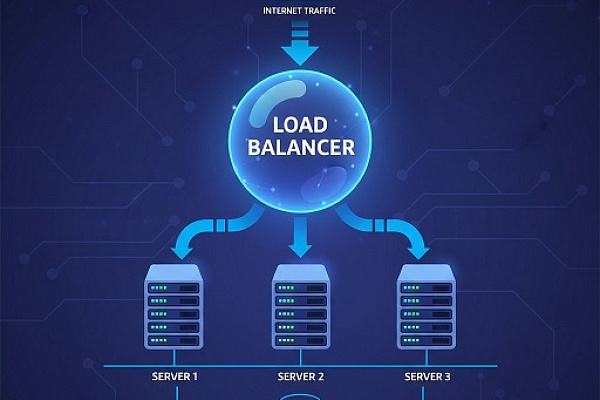A load balancer acts as a "traffic cop" for your network, efficiently distributing incoming client requests across a pool of backend servers. This prevents any single server from becoming overwhelmed, ensuring smooth and reliable application performance. While load balancing technology has existed for decades, its evolution has been supercharged by the advent of cloud computing. Server virtualization enabled the creation of dynamic, self-healing systems that can automatically redistribute load when a server reaches capacity.
The demand for cloud-native load balancers is clear. With global data traffic continuing to soar, data centers face unprecedented pressure. A robust load balancing solution is no longer a luxury but a fundamental requirement for operational continuity.
Traditional hardware-based load balancers struggled to keep pace with this explosive traffic growth, often requiring costly and complex hardware expansions. In response, agile and scalable cloud solutions have emerged as the modern standard.
The Critical Role of Load Balancing
As outlined above, load balancing is essential for intelligently distributing workloads across multiple devices. Without it, overburdened servers are prone to failure, which can disrupt critical business processes and lead to significant financial and reputational damage.
For mission-critical applications, a load balancer is indispensable. The resources of any single server are finite. Pushing a server beyond its limits can cause catastrophic failures. A load balancer eliminates this single point of failure, creating a resilient infrastructure.
Furthermore, by preventing servers from constantly operating at maximum capacity, load balancers help reduce long-term hardware degradation. This proactive management extends the life of your underlying resources.
Ultimately, load balancers provide the foundation for scalable, manageable networks. They empower digital businesses to grow rapidly while delivering high performance, robust security, and consistent application availability for all types of services.
How a Load Balancer Operates
Imagine a busy intersection with multiple lanes. If one car breaks down, traffic in that lane grinds to a halt, creating a bottleneck for everyone. A load balancer acts like a skilled traffic controller, dynamically routing "vehicles" (user requests) to ensure a smooth, continuous flow without overloading any single "road" (server).
From a user's perspective, accessing an online service is simple—they just type a domain name or IP address. Behind the scenes, the load balancer does the complex work. It presents a single virtual IP address (VIP) to the public, then distributes incoming requests to a pool of backend servers based on a chosen distribution algorithm.
Here are some of the most common algorithms:
-
Round Robin: Requests are distributed sequentially to each server in the pool. This method is simple, protocol-agnostic, and low-cost. However, it assumes all servers have equal capacity and does not account for their current load, potentially overloading a slower server.
-
Weighted Round Robin: An enhancement of Round Robin, this algorithm assigns a performance "weight" to each server. More powerful servers with a higher weight receive a larger proportion of the traffic.
-
Least Connections: This intelligent method directs new requests to the server with the fewest active connections at that moment. It is highly effective for maintaining even load distribution across servers with varying connection times.
Cloud4Y's load balancer supports these and other algorithms, allowing you to select the optimal strategy for your specific needs.
Best Practices for Load Balancer Management
To maximize the effectiveness of your load balancing setup, follow these key practices:
-
Leverage Multiple Availability Zones: Deploy your cloud resources across different availability zones. This ensures that your applications remain online and performant even if an entire zone experiences an outage.
-
Standardize Your Deployment: Maintain a consistent number of virtual machines across your availability zones. This standardization simplifies management and promotes predictable performance.
-
Build in Redundancy: Always plan for failure. If a virtual machine fails, the traffic it was handling must be absorbed by the remaining servers. We recommend maintaining a "safety reserve" of extra capacity in each zone to handle such spikes without impacting performance.
-
Dedicate Balancers per Application: For infrastructures hosting multiple applications, configure dedicated load balancers for each. This practice isolates potential issues, enhances security, and simplifies troubleshooting.
Conclusion
Modern cloud-based load balancing solutions represent a significant leap forward in efficiency and reliability. They enable smarter use of server hardware while guaranteeing consistent service delivery. By implementing a cloud load balancer, such as VMware NSX Edge, you transform your infrastructure from a fragile chain of single points of failure into a resilient, scalable, and highly available environment.




